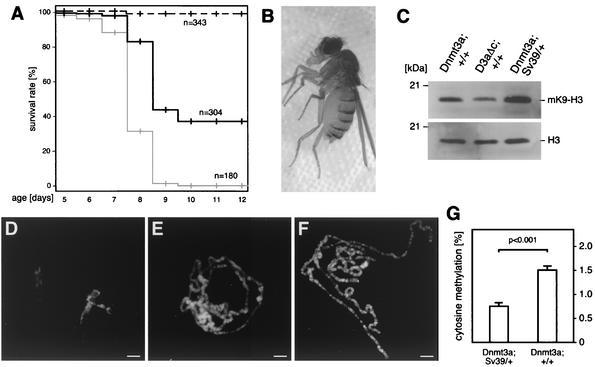FIG. 6.
Rescue of DNA hypermethylation-induced phenotype by Su(var)3-9 mutations in H3-K9 methyltransferase. (A) Survival of flies was calculated by determining their stage of developmental arrest during pupal development. Flies overexpressing Dnmt3a in a wild-type Su(var)3-9 background are shown as a grey line, and flies overexpressing Dnmt3a in a heterozygous Su(var)3-9 null mutant background are shown as a black line. The mutant allele as such showed no detectable effect on fly development (dashed black line). For each experiment, we analyzed several independent crosses. (B) Rescued adult flies were viable and fertile and had a normal appearance. (C) Western analysis indicated larger amounts of methylated K9-H3 both in third-instar larvae overexpressing Dnmt3a in a wild-type background and in a heterozygous Su(var)3-9 mutant background. See text for details. (D to F) Rescue of the polytene chromosome phenotype. Bars, 10 μm. (D) No polytene chromosomes could be prepared from flies overexpressing Dnmt3a in a wild-type background. (E) The presence of a heterozygous mutant Su(var)3-9 allele resulted in the appearance of polytene chromosomes that were similar to wild-type chromosomes. (F) Overexpression of the catalytically inactive Dnmt3a protein combined with a heterozygous Su(var)3-9 mutation had no effect on polytene chromosome morphology. (G) Quantification of genomic DNA methylation levels in rescued (Dnmt3a; Sv39/+) and nonrescued (Dnmt3a; +/+) pupae. The reduction of H3-K9 methylation in rescued flies resulted in a significant decrease of the genomic DNA methylation level (P < 0.001, as determined by a standard t test).

